Related Research Articles

The Euphrates is the longest and one of the most historically important rivers of Western Asia. Together with the Tigris, it is one of the two defining rivers of Mesopotamia. Originating in Turkey, the Euphrates flows through Syria and Iraq to join the Tigris in the Shatt al-Arab, which empties into the Persian Gulf.
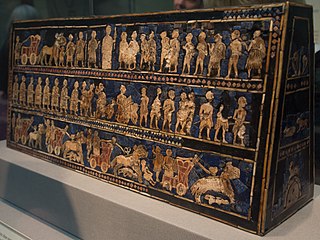
Ancient history is the aggregate of past events from the beginning of writing and recorded human history and extending as far as late antiquity. The span of recorded history is roughly 5,000 years, beginning with the Sumerian cuneiform script. Ancient history covers all continents inhabited by humans in the period 3000 BCE – 500 CE. The three-age system periodizes ancient history into the Stone Age, the Bronze Age, and the Iron Age, with recorded history generally considered to begin with the Bronze Age. The start and end of the three ages varies between world regions. In many regions the Bronze Age is generally considered to begin a few centuries prior to 3000 BCE, while the end of the Iron Age varies from the early first millennium BCE in some regions to the late first millennium CE in others.
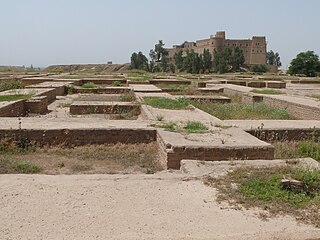
Susa was an ancient city in the lower Zagros Mountains about 250 km (160 mi) east of the Tigris, between the Karkheh and Dez Rivers in Iran. One of the most important cities of the Ancient Near East, Susa served as the capital of Elam and the Achaemenid Empire, and remained a strategic centre during the Parthian and Sasanian periods.

The history of Sumer spans the 5th to 3rd millennia BCE in southern Mesopotamia, and is taken to include the prehistoric Ubaid and Uruk periods. Sumer was the region's earliest known civilization and ended with the downfall of the Third Dynasty of Ur around 2004 BCE. It was followed by a transitional period of Amorite states before the rise of Babylonia in the 18th century BCE.
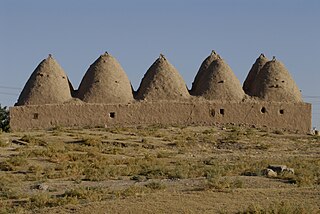
Harran, also known as Carrhae, was a major ancient city in Upper Mesopotamia whose site is in the modern village of Harran, Turkey, 44 kilometers southeast of Şanlıurfa. The location is in the Harran district of Şanlıurfa Province.

Lagash, or Shirpurla, was an ancient city state located northwest of the junction of the Euphrates and Tigris rivers and east of Uruk, about 22 kilometres (14 mi) east of the modern town of Ash Shatrah, Iraq. Lagash was one of the oldest cities of the Ancient Near East. The ancient site of Nina is around 10 km (6.2 mi) away and marks the southern limit of the state. Nearby Girsu, about 25 km (16 mi) northwest of Lagash, was the religious center of the Lagash state. Lagash's main temple was the E-ninnu, dedicated to the god Ningirsu. Lagash seems to have incorporated the ancient cities of Girsu, Nina, Uruazagga and Erim.

The First Dynasty of Ur was a 26th-25th century BCE dynasty of rulers of the city of Ur in ancient Sumer. It is part of the Early Dynastic period III of the history of Mesopotamia. It was preceded by the earlier First Dynasty of Kish and the First Dynasty of Uruk.
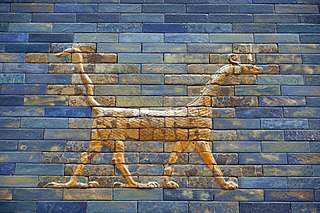
The mušḫuššu or mushkhushshu, is a creature from ancient Mesopotamian mythology. A mythological hybrid, it is a scaly animal with hind legs resembling the talons of an eagle, lion-like forelimbs, a long neck and tail, a horned head, a snake-like tongue, and a crest. The mušḫuššu most famously appears on the reconstructed Ishtar Gate of the city of Babylon, dating to the sixth century BCE.

Enmebaragesi (Sumerian:𒂗𒈨𒁈𒄄𒋛) originally Mebarasi (Sumerian:𒈨𒁈𒋛) was the penultimate king of the first dynasty of Kish and is recorded as having reigned 900 years in the Sumerian King List. Like his son and successor Aga he reigned during a period when Kish had hegemony over Sumer. Enmebaragesi signals a momentous documentary leap from mytho-history to history, since he is the earliest ruler on the king list whose name is attested directly from archaeology.

Ancient Mesopotamian units of measurement originated in the loosely organized city-states of Early Dynastic Sumer. Each city, kingdom and trade guild had its own standards until the formation of the Akkadian Empire when Sargon of Akkad issued a common standard. This standard was improved by Naram-Sin, but fell into disuse after the Akkadian Empire dissolved. The standard of Naram-Sin was readopted in the Ur III period by the Nanše Hymn which reduced a plethora of multiple standards to a few agreed upon common groupings. Successors to Sumerian civilization including the Babylonians, Assyrians, and Persians continued to use these groupings. Akkado-Sumerian metrology has been reconstructed by applying statistical methods to compare Sumerian architecture, architectural plans, and issued official standards such as Statue B of Gudea and the bronze cubit of Nippur.
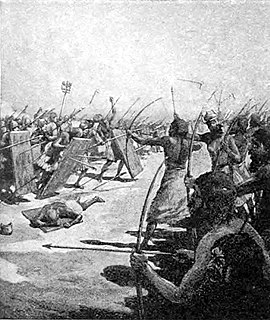
Lugal-Anne-Mundu was the most important king of the city-state of Adab in Sumer. The Sumerian king list claims he reigned for 90 years, following the defeat of Mesh-ki-ang-Nanna II, son of Nanni, of Ur. There are few authentic contemporary inscriptions for Lugal-Anne-Mundu's reign; he is known mainly from a much later text, purporting to be copied from one of his inscriptions.

Ibbi-Sin, son of Shu-Sin, was king of Sumer and Akkad and last king of the Ur III dynasty, and reigned c. 2028–2004 BCE or possibly c. 1964–1940 BCE. During his reign, the Sumerian empire was attacked repeatedly by Amorites. As faith in Ibbi-Sin's leadership failed, Elam declared its independence and began to raid as well.

Pre-Islamic Arabia refers to the Arabian Peninsula prior to the emergence of Islam in 610 CE.

The Awan Dynasty was the first dynasty of Elam of which very little of anything is known today, appearing at the dawn of historical record. The Dynasty corresponds to the early part of the Old Elamite period, it was succeeded by the Shimashki Dynasty and later the Sukkalmah Dynasty. The Elamites were likely major rivals of neighboring Sumer from remotest antiquity; they were said to have been defeated by Enmebaragesi of Kish, who is the earliest archaeologically attested Sumerian king, as well as by a later monarch, Eannatum I of Lagash.

Eannatum was a Sumerian Ensi of Lagash circa 2500–2400 BCE. He established one of the first verifiable empires in history: he subdued Elam and destroyed the city of Susa as well as several other Iranian cities, and extended his domain to Sumer and Akkad. One inscription found on a boulder states that Eannatum was his Sumerian name, while his "Tidnu" (Amorite) name was Lumma.

The ancient Near East was the home of early civilizations within a region roughly corresponding to the modern Middle East: Mesopotamia, ancient Egypt, ancient Iran, Anatolia/Asia Minor and the Armenian Highlands, the Levant, Cyprus and the Arabian Peninsula. The ancient Near East is studied in the fields of Ancient Near East studies, Near Eastern archaeology and ancient history.

The Amorites were an ancient Northwest Semitic-speaking people from the Levant who also occupied large parts of southern Mesopotamia from the 21st century BC to the end of the 17th century BC, where they established several prominent city-states in existing locations, such as Isin, Larsa and later notably Babylon, which was raised from a small town to an independent state and a major city. The term Amurru in Akkadian and Sumerian texts refers to the Amorites, their principal deity and an Amorite kingdom.

Indus–Mesopotamia relations are thought to have developed during the second half of 3rd millennium BCE, until they came to a halt with the extinction of the Indus valley civilization after around 1900 BCE. Mesopotamia had already been an intermediary in the trade of lapis lazuli between the Indian subcontinent and Egypt since at least about 3200 BCE, in the context of Egypt-Mesopotamia relations.

The Sukkalmah Dynasty, also Epartid Dynasty after the founder Eparti/Ebarat, was an early dynasty of West Asia in the ancient region of Elam, to the southeast of Babylonia. It corresponds to the latest part of the Old Elamite period.
Meskigal was a Sumerian ruler of the Mesopotamian city of Adab in the mid-3rd millennium BCE, probably circa 2350 BCE. He was contemporary with Lugal-zage-si and the founder of the Akkadian Empire, Sargon of Akkad.
References
- ↑ Weidmann (1994). Nikephoros - Zeitschrift für Sport und Kultur im Altertum. Georg Olms Verlag. p. 7. ISBN 3-615-00137-0.
- ↑ Arnold Joseph Toynbee; David Churchill Somervell (1947). A Study of History: Abridgement of Volumes I-VI. Oxford University Press. p. 550.